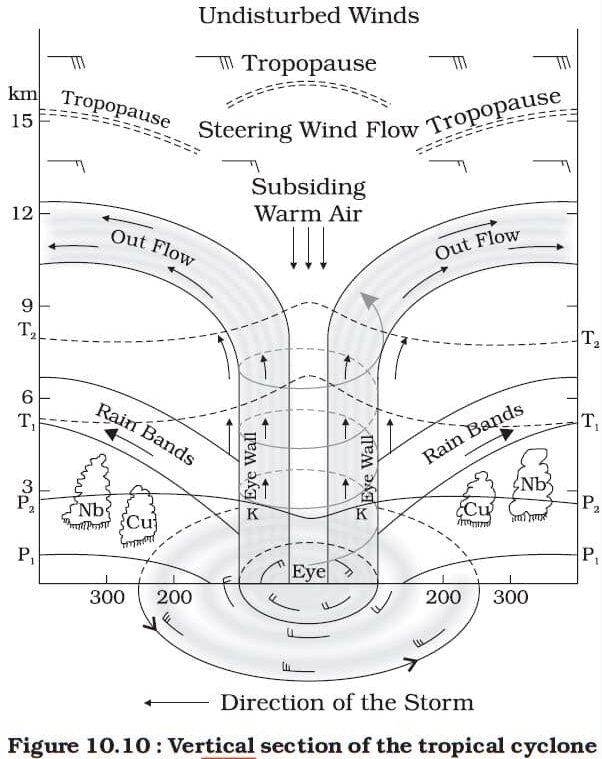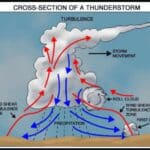Table of Contents
Tropical Cyclones its Characteristics, Origin and Significance | UPSC- IAS
Geographically tropical atmosphere lies between the Tropic of Cancer and the Tropic of Capricorn. But in meteorology, the boundaries of the tropical atmosphere are determined on the high pressure cells of the subtropics. There are various kinds of weather disturbances exist within the tropics. Great deals of variations are observed in weather elements like temperature, precipitation and pressure etc. It is due to the amount of insolation received in the tropics. Ocean currents also contributes a lot to the transfer of heat to the higher latitudes. The rate of exchange of energy between the oceans and sphere is greater in the tropics.
Tropical disturbances are classified in to four categories:
- Easterly waves
- Tropical depressions
- Tropical storms
- Hurricane and Typhoons
Easterly waves:
- These are the migratory waves which move from east to west at a lower speed. The source of the occurrence lies between 5°-30° latitudes in both the hemisphere. These waves travel in east to west direction at the rate at 32°-48° kms per day.
Tropical depressions:
- Petterssen defines the tropical depressions as the center of low pressure around which the wind velocity hardly exceeds 40 km/hr. The depressions can occur anywhere, but they are quite frequent in the vicinity of Inter Tropical Convergence Zone (lTCZ). These depressions never grow in to storms of hurricane intensity; rather they die out as weak disturbances.
Tropical storms:
- Most favorable atmospheric conditions for their occurrence exist during summer Bay of Bengal and Arabian Sea offer ideal conditions for the origin of these storms. These storms produce heavy precipitation and bring about change in Weather. They are more violent and destructive type of tropical storms.
Tropical cyclones (Hurricane or Typhoons)
- Hurricane is a severe tropical cyclone having a maximum speed of 119 kms/hr. the name ‘hurricane’ is given to the tropical cyclone in N. Atlantic and eastern N. Pacific Ocean. In the western N. pacific they are known as typhoons. In Australia they call it as Willy-Willy, where as in the Indian Ocean they are called cyclones. In Philippines it is called ‘bagnio’. Japanese call these storms as ‘taifu.’. Elsewhere they are just called as ‘tropical cyclones’.
- Hurricanes present the most violent, most awesome, and most feared of all the atmospheric disturbances. According to Byers the tropical cyclones differ from the mid latitude cyclones. The tropical cyclones are found at certain seasons in well defined areas it the tropics. They form only over ocean having a high surface temperature (27°c). They to have fronts nor are they associate with moving cyclones. They derive their energy the latent heat of condensations.
Characteristics of Tropical Storms | UPSC – IAS
- The chief characteristics of these violent tropical storms are low pressure at the center d high wind velocity. Tropical hurricanes are nearly circular measuring 500 to 600 kms in diameter. It extends almost 12,000 mts. above MSL. They last for many days, in certain cases more than a week. According to Trewartha, there is a spiralling inflow of air at lower levels, a rapid movement at intermediate levels and a spiraling out wand flow aloft.
- From the central low pressure core of the cyclone, winds converging from all directions are whirled upward. As a result of the lifting of air, condensation starts producing cumulonimbus clouds.
- Structure: At the center the pressure is lowest. This is called the hurricane eye. The diameter ranges from 20 to 40 kms. In this central zone the winds are light & variable.
- The temperature is abnormally high. The hurricane eye is undoubtedly the warmest part of the storms. Heaviest precipitation is also recorded in the vicinity of this region.
- In a well developed hurricane the movement of the wind in the Northern hemisphere in an anticlockwise and clockwise in the southern hemisphere. The pressure gradients are always steep. The velocity of the wind will be around 120 to 200 kms.hr. They produce large waves on the oceans. Near the core of the hurricane, there is a thick mass of clouds yields heavy rainfall. In extreme cares more than 50 cms of precipitation may accumulate in one place. Rainfall diminishes towards the center where there is no rain at all.
Origin of Tropical Cyclones (Hurricanes) | UPSC – IAS
- Tropical cyclone is like a heat engine that is energized by the latent heat of condensation.
- The amount of energy released in a hurricane is estimated to be equal to the total amount of electricity consumed in the US over 6 months period. The energy liberated within a hurricane in one day is almost ten thousand times the daily power consumptions in the entire US. The energy released within a hurricane is equal to about 1,000 bombs of megaton strength.
Movement and tracks of Hurricanes:
- Hurricanes after their formation usually move towards the west and always from the equator. Their average speed is about 15 to 30 kms/hr. They also move along the trade winds and westerlies. Warm ocean currents also affect the path of cyclones. After reaching the western part of the tropical oceans, the cyclones curve towards the pole. When they –meet westerlies, the hurricane move with a speed of 100 kms/hr. whenever a tropical cyclone moves on land, the severity is reduced due to the absence of moisture. In other words no energy is available on land to maintain a cyclone. Therefore tropical cyclones always originate over oceans than land.
- On Indian Ocean the movement of the tropical cyclones is different because these storms are influenced by monsoon circulation, and they move in northerly direction along with the monsoon currents.
- Storms originating over Caribbean Sea regions move westward towards Texas and Mexico. The storms that develop in the western part of the north pacific region move through the Philippines and north and toward China and Japan. In north Atlantic region high frequencies of tropical cyclones are fond in the months of Aug. Sept & Oct. The period from December to May is free from cyclones in the south western north pacific. Greatest frequencies are seen from July to October. There are no cyclones from February to April in these regions. There are no hurricanes in south Atlantic regions due to the fact that the tropical convergence zone remains to the north of the equator so that no weak tropical disturbance develops over this ocean.
Regional Distribution of Tropical Cyclones
There are six regions of tropical cyclones
- Tropical North Atlantic – West Indies, Gulf of Mexico and Caribbean sea, –
- Western part of the tropical North Pacific- Philippines, the China Sea and areas around Japan Eastern part of the tropical North pacific- western coastal areas of Mexico and central America The Bay of Bengal and Arabian sea
- The South Indian oceans – Fiji Islands and east coast of Australia
Environmental Importance of Tropical Cyclones | UPSC – IAS
Tropical cyclones are the most destructive and violent type of storms. Islands and coastal settlements are the targets of there cyclones.
- Cyclones are associated with high pressure gradients and consequent strong winds, these in term generate storm surge. A storms surge is an abnormal rise of sea level near the cost caused by severe tropical cyclones, as a result sea water enters in to the low lying areas of coastal regions drowning human beings and live stocks, eroding beaches and destroying vegetation. Very strong winds may damage installations, dwellings, communication systems, trees, etc. resulting in loss of life and property. Heavy and prolonged rains may cause river floods, pollute drinking water sources causing outbreak of epidemics.
- It may be mentioned that all the factors mentioned above occur simultaneously and, therefore, relief operations for distress mitigation become difficult. So it is imperative that advance action is taken for relief measures before the commencement of adverse weather conditions due to cyclones.
- The most destructive element associated with an intense cyclone is storm surge. Past history indicates that loss of life is significant when surge magnitude is 3 metres or more and catastrophic when 5 meters and above.



